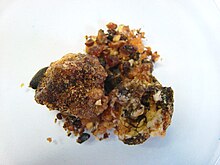| Commiphora guidottii | |
|---|---|

| |
| The oleo-gum-resin of C. guidottii | |
| Scientific classification | |
| Kingdom: | Plantae |
| Clade: | Tracheophytes |
| Clade: | Angiosperms |
| Clade: | Eudicots |
| Clade: | Rosids |
| Order: | Sapindales |
| Family: | Burseraceae |
| Genus: | Commiphora |
| Species: | C. guidottii
|
| Binomial name | |
| Commiphora guidottii Chiov. ex Guid.
| |
| Synonyms[1] | |
| |
Commiphora guidottii, commonly known as scented myrrh or bisabol, is a tree or shrub species that is native to the countries of Somalia and Ethiopia. Essential oil from its oleo-gum-resin has been researched for its use in topical treatment of wounds.[2][3]
Distribution[edit]
Commiphora guidottii is native to two territories in the horn of Africa; the Ogaden region of eastern Ethiopia, and Somalia. The tree is widely known in the Bari, Bakool, Galguduud, Gedo, Mudug, and Nugal regions of Somali where to the locals it is known as hadi or habakhadi.[4] The growth of the tree is associated with gypsum producing areas and in open bushland. [2]
Uses[edit]
Historically, the essential oils and gum resin of C. guidottii is an export commodity from Somaliland, but considered to be inferior in quality to the resin obtained from its sister species, C. myrrha. The shrub is sometimes mixed with the forage given to milk producing cows so as to improve the quantity and quality of milk.[4]
References[edit]
- ^ "Commiphora guidottii". Global Biodiversity Information Facility. Retrieved 17 June 2021.
- ^ a b Gebrehiwot M, Asres K, Bisrat D, Mazumder A, Lindemann P, Bucar F (August 2015). "Evaluation of the wound healing property of Commiphora guidottii Chiov. ex. Guid". BMC Complementary and Alternative Medicine. 15 (1): 282. doi:10.1186/s12906-015-0813-2. PMC 4538748. PMID 26283230.
- ^ Craveiro A, Corsano S, Proietti G, Strappaghetti G (June 1983). "Constituents of essential oil of Commiphora guidotti". Planta Medica. 48 (2): 97–8. doi:10.1055/s-2007-969896. PMID 17404960.
- ^ a b Thulin M, Claeson P (1991). "The botanical origin of Scented Myrrh (Blssabol or Habak Hadi)". Economic Botany. 45 (4): 487–494. doi:10.1007/BF02930711. ISSN 0013-0001. S2CID 22229398.